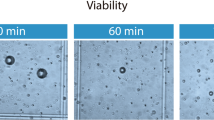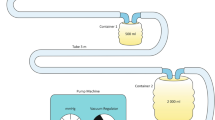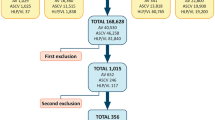Abstract
Background
Suction-assisted lipoplasty (SAL; liposuction) is an established aesthetic procedure in plastic surgery. The main parameters differentiating one method of lipoplasty from another are safety, consistency of results, and other more technical parameters. Due to the recent popularity of lipotransfer, the quality of extracted fat has become a relevant parameter. We compare the viability of extracted adipocytes after dry SAL, hyper-tumescent PAL (power-assisted lipoplasty), and water-assisted lipoplasty (WAL).
Methods
We used fluorescent microscopy to differentiate viable from necrotic/apoptotic cells after liposuction using each of the mentioned methods.
Results
The ratio of living cells between the three methods was significantly different with dry liposuction yielding inferior ratios (p = 0.011). When omitting extreme results, we found that the body-jet technique (WAL) yielded higher ratios of living cells than the hyper-tumescent technique (p < 0.001). The total number of cells was highest in the hyper-tumescent method (p = 0.013).
Conclusions
Our results indicate that the hyper-tumescent technique yields the highest number of cells, whereas the body-jet technique yields the highest living cells ratio. The dry technique is clearly inferior to both.
No Level Assigned
This journal requires that authors assign a level of evidence to each article. For a full description of these Evidence-Based Medicine ratings, please refer to the Table of Contents or the online Instructions to Authors www.springer.com/00266.




Similar content being viewed by others
References
Hetter GP, Herhahn F (1983) Experience with “lipolysis”: the Illouz technique of blunt suction lipectomy in North America. Aesthet Plast Surg 7(2):69–76
Illouz YG (1983) Body contouring by lipolysis: a 5-year experience with over 3000 cases. Plast Reconstr Surg 72(5):591–597
Klein JA (1990) Tumescent technique for regional anesthesia permits lidocaine doses of 35 mg/kg for liposuction. J Dermatol Surg Oncol 16(3):248–263
Klein JA (1990) The tumescent technique. Anesthesia and modified liposuction technique. Dermatol Clin 8(3):425–437
Lauber JS, Abrams HL, Coleman WP 3rd (1990) Application of the tumescent technique to hand augmentation. J Dermatol Surg Oncol 16(4):369–373
Apfelberg D (1992) Laser-assisted liposuction may benefit surgeons, patients. Clin Laser Mon 10(12):193–194
Zocchi M (1992) Ultrasonic liposculpturing. Aesthet Plast Surg 16(4):287–298
Dillerud E, Heden P (1993) Circulation of blood and viability after blunt suction lipectomy in pig buttock flaps. Scand J Plast Reconstr Surg Hand Surg 27(1):9–14
Baker TM et al (1996) What’s new in aesthetic surgery. Clin Plast Surg 23(1):3–16
Dolsky RL (1990) Blood loss during liposuction. Dermatol Clin 8(3):463–468
Apfelberg DB et al (1994) Progress report on multicenter study of laser-assisted liposuction. Aesthet Plast Surg 18(3):259–264
Ducic Y, Pontius AT, Smith JE (2003) Lipotransfer as an adjunct in head and neck reconstruction. Laryngoscope 113(9):1600–1604
Ducic Y (2008) Fat grafting in trauma and reconstructive surgery. Facial Plast Surg Clin North Am 16(4):409–416 v–vi
Williams EF 3rd, Smith SP Jr (2007) Minimally invasive midfacial rejuvenation: combining thread-lift and lipotransfer. Facial Plast Surg Clin North Am 15(2):209–219 vii
DeFatta RJ, Williams EF 3rd (2008) Fat transfer in conjunction with facial rejuvenation procedures. Facial Plast Surg Clin North Am 16(4):383–390 v
Smith P et al (2006) Autologous human fat grafting: effect of harvesting and preparation techniques on adipocyte graft survival. Plast Reconstr Surg 117(6):1836–1844
Fournier PF, Otteni FM (1983) Lipodissection in body sculpturing: the dry procedure. Plast Reconstr Surg 72(5):598–609
Dolsky RL (1984) Body sculpturing by lipo-suction extraction. Aesthet Plast Surg 8(2):75–83
Sasaki GH (2011) Water-assisted liposuction for body contouring and lipoharvesting: safety and efficacy in 41 consecutive patients. Aesthet Surg J 31(1):76–88
Sattler G et al (1999) Tumescent liposuction in Germany: history and new trends and techniques. Dermatol Surg 25(3):221–223
Son D et al (2010) Viability of fat cells over time after syringe suction lipectomy: the effects of cryopreservation. Ann Plast Surg 65(3):354–360
Macrae JW et al (2003) Human adipocyte viability testing: a new assay. Aesthet Surg J 23(4):265–269
Jones KH, Senft JA (1985) An improved method to determine cell viability by simultaneous staining with fluorescein diacetate–propidium iodide. J Histochem Cytochem 33(1):77–79
Agostini T et al (2012) Wet and dry techniques for structural fat graft harvesting: histomorphometric and cell viability assessments of lipoaspirated samples. Plast Reconstr Surg 130(2):331e–339e
Matsumoto D et al (2006) Cell-assisted lipotransfer: supportive use of human adipose-derived cells for soft tissue augmentation with lipoinjection. Tissue Eng 12(12):3375–3382
Yoshimura K et al (2008) Cell-assisted lipotransfer for cosmetic breast augmentation: supportive use of adipose-derived stem/stromal cells. Aesthet Plast Surg 32(1):48–55 discussion 56–7
Author information
Authors and Affiliations
Corresponding author
Ethics declarations
Conflict of Interest
The authors declare that they have no conflicts of interest to disclose.
Additional information
This study was presented in the “Oncoplastic & Reconstructive Surgery of the Breast” meeting in Milan, Italy/December 2011.
Rights and permissions
About this article
Cite this article
Harats, M., Millet, E., Jaeger, M. et al. Adipocytes Viability After Suction-Assisted Lipoplasty: Does the Technique Matter?. Aesth Plast Surg 40, 578–583 (2016). https://doi.org/10.1007/s00266-016-0645-6
Received:
Accepted:
Published:
Issue Date:
DOI: https://doi.org/10.1007/s00266-016-0645-6




